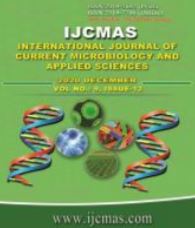


 National Academy of Agricultural Sciences (NAAS)
National Academy of Agricultural Sciences (NAAS)

|
PRINT ISSN : 2319-7692
Online ISSN : 2319-7706 Issues : 12 per year Publisher : Excellent Publishers Email : editorijcmas@gmail.com / submit@ijcmas.com Editor-in-chief: Dr.M.Prakash Index Copernicus ICV 2018: 95.39 NAAS RATING 2020: 5.38 |
The analysis of variance indicated the existence of sufficient amount of variability among genotypes for all the characters studied except foliage senescence percent recorded highly significance, which is indicating that the genotypes were widely variable. The phenotypic variance was in general higher than the genotypic variance for all the characters. High heritability coupled with high genetic advance was recorded for the traits viz. number of leaf plant-1, marketable tuber yield, tuber rottage, total tuber yield. Hence, these characters were predominantly governed by additive gene action and can be improved through simple selection. Genotypes were grouped into five distinct clusters depending upon the similarities of their D2 values. The maximum numbers of five genotypes were included in cluster-IV and maximum genetic divergence 4.008 was noted between cluster II and III. The highest cluster mean values recorded for premium characters viz. Number of leaf plant-1 in cluster-I, plant height in cluster-II, Seed weight plat-1, in cluster III, % emergence in cluster IV, foliage senescence in Cluster I, marketable tuber yield in cluster-V, minimum tuber rottage in cluster II, tuber dry matter in cluster IV, Haulm dry matter in cluster IV and Total tuber yield in cluster V. Hence, genotypes having maximum distances should be selected from different clusters and can be utilized in hybridization programme for producing more desirable segregants for seed yield.
 |
 |
 |
 |
 |